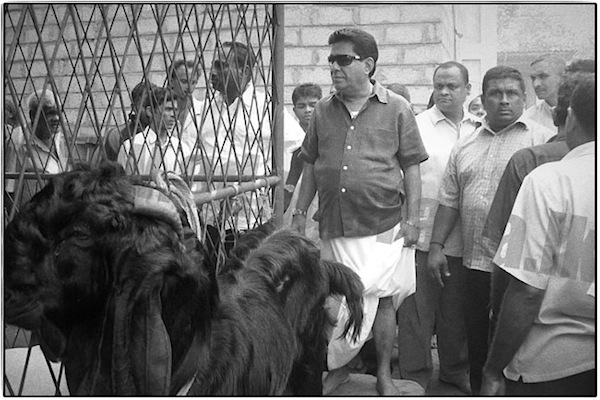Photo courtesy Ada Derana
My new neighbour, a quiet middle class, young Sinhala Buddhist professional from beyond Matara, who started constructing his own house, brought down a “Kattadi mahathtaya” from his village to evoke blessings on the property, the new construction and on himself and his young family, before the foundation stone was laid. The ritual went on with loud chanting and drumming through midnight, a public nuisance, but tolerated in silence, as it was his belief for which he also had a right. Early morning we woke up when a cockerel screamed it’s life out. The final sacrifice of a “life” made in this ritual called the “Bhahirava poojah”.
This is no isolated event in this Sinhala Buddhist society, where people construct their own houses and often indulge in such sacrificial poojahs. May be there are other similar rituals too, when “life” of animals and birds are sacrificed, in lieu of a safe and prosperous future for the person(s) who provides that animal/bird life to his or her preferred God.
Yet, this year when in Munneswaran Kaali Temple, the annual festival had goats and poultry lined up for “sacrifice” by Tamil Hindu devotees, this Sinhala society took it upon themselves to go against “cruelty to animals” at this Hindu festival and stop their religious ritual.
Munneswaran temple had been in existence, even before the 12 century, as records say, King Parakramabahu who had the whole island under his reign, brought down an artisan – “Silpačãri” – group from Kapilavastupura to renovate the temple. Pleased with the work, the king had conferred the title “Mutugala Rãjakarunadi Viravardana Viskammandana Ačãri” and given land for the whole group to “reside and enjoy until the sun and the moon would last”.
This ritual of animal sacrifice, is thus over 10 centuries old in practice and the annual festival with animal sacrifice at Munneswaran is a Hindu religious belief that had continued for that long. After all these centuries of seeing, accepting and may be participating in this animal sacrifice, what provoked the Sinhala Buddhists to go hard line “animal lovers” ?
There is definitely “Sinhala politics” in it, for the Sinhala Buddhists to take up cudgels against this ritual, as it is now practised by only the Tamil Hindus in this form of a festival. The hyped trend against other minority religions is an extension of what was cropping up now and then against different unorthodox Christian sects over the past decade or two. On 10th September Saturday, reports say a Buddhist monk, Amatha Dhamma thero led a mob of Sinhala youth to destroy an ancient Muslim “shrine” within the Anuradhapura sacred city. The Buddhist monk’s claim according to a BBC report was that, the land belonged to Sinhala Buddhists for over 2,000 years.
If historical length is the defining factor for ownership, then a 10 century old religious ritual is also one that can not be denied. Tamil Hindus thus have a right to continue with their religious identity where the festival at Munneswaran with animal sacrifice is a historical presence. It is for that reason, the Sinhala Buddhist fundamentalists have opted to use the slogan, “stop cruelty to animal” for that fits in with “Buddhist compassion” and also the modern law. Thus Mervyn who tied a public servant to a tree, attacked the media every now and then and leans on ugly, obscene retorts on TV shows, too becomes a “lovable” hero for this Sinhala Buddhist gallery.
What nevertheless baffles rationality in this argument against animal sacrifice is, why they were not worried about killing of animals for sacrifice, all these decades. Why suddenly now? Is cruelty to animal defined in terms of “killing for sacrifice” and not on “killing for human consumption”? There can not be any difference to an animal, whether it is taken to Munneswaran kovil to be beheaded as a sacrifice, or to a Municipal slaughterhouse, to be killed and sold.
Even in Sri Lanka, Tamil Hindus don’t consume “beef” for they take the cow as holy. Beef is consumed only by other religious groups including Buddhists, Christians and Muslims. Some one would have to do a count on cattle that is slaughtered daily in municipal and other licensed slaughterhouses, for their consumption. In 2004, the Colombo Municipal Council had a project to renovate and modernise their Dematagoda slaughterhouse to accommodate 250 cattle per day.
Goats have become more popular with scattered campaigns against slaughter of cattle. A survey done on goats and their diseases by the Peradeniya Veterinary Research Institute and the Colombo Municipal Council, led by R.P.V.J Rajapaksa and A.C.M. Faizal has recorded that around 125,000 goats are slaughtered annually in Sri Lanka, for consumption.
According to Sunday Times (10 April, 2011), the present demand for chicken is around 8.5 to 09 million kg per month as told by the Chairman, All Island Poultry Association of Sri Lanka. That’s about 102 to 108 million kg annually and roughly about 70 million birds killed every year. The best part of these lives definitely go to feed the Sinhala society. This is leaving aside all the billions of lives of fish, eaten and exported dead.
“Life” in Buddhism has no varying values according to varying kinds and sizes of animals, birds and fish. There is also no justification in Buddhism for killing animals, birds and fish, for any reason. “Killing” is killing and killing cannot be any humane, when killed for consumption.
Where then is this Buddhist campaign against cruelty to animals perched, with its consumption of thousands of metric tons of animal flesh ? There certainly is a politico religious bias in this intervention that obstructed a religious belief. A racist bias, against the minorities. It can not be otherwise, in this heavily omnivorous Sinhala Buddhist society.
